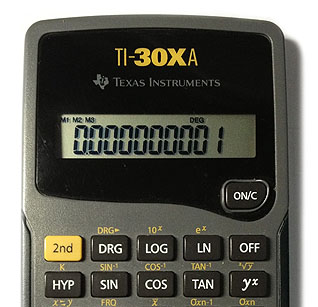Proper USE of the Scientific Calculator
Chemistry is a quantitative science and many of the calculations that we do as chemists require adding, subtracting, multiplying, and dividing extremely large and extremely small numbers. Think of Avogadro's number, 6.022 × 1023. That number will never fit on the display of a "regular" calculator. That's why we use scientific calculators that have scientific notation mode (SCI mode).
Learn the POWER of SCI MODE!
Even "cheap" Scientific Calculators are Plenty Accurate
I often hear students talking about how their "powerful" graphing calculator is "smarter" than their simple plain scientific calculator (like the TI-30x). Some students will work a problem over and over and then conclude that their calculator is just plain wrong. Then they want to use their "good" calculator for the exam and not their "dumb" one. HOLD ON! It isn't the calculator with the problem - it's actually you and your failure to learn how to properly use the tools of the trade so to speak.
Lesson: Scientific Calculators 101
When your calculator is turned on, the default setting (unless you've changed it) is for floating point math and display (this is generally true for both graphing and scientific calculators). This means that the display will show any number as a decimal number until the display cannot physically show the number. Then and only then will the calculator resort to SCI mode automatically (showing exponential notation). Most simple scientific calculators have 10-digit displays. This can lead to BIG errors if you are not careful.
Example of Student ERROR
Many students will write down a number as seen from the calculator display. Then when they need the number back, they re-enter it. This can lead to BIG errors (not always, but CAN).. Here's an example of what COULD happen to you if you are not careful.
Divide 1.25x10-7 by 100. What do you get? I can actually do that in my head, the correct answer is 1.25 x 10-9. However, on my calculator, I did it and I got what you see displayed here.

...which if I just copy it down somewhere is VERY WRONG. It's actually 20% off and could be as much as 50% off. What's sad (for those of you who cleared the display) is that the valid and accurate number is still in there, it's just that the DISPLAY can't show more than 10 digits. And it will show all it can before resorting to SCI mode when the calculator is in FLOAT mode. As long as I don't clear the display, that number will still work - the "2" and the "5" are still there, you just can't SEE them (try it, now multiply by 10, by 10 again. You'll bring those numbers back on to the display). It will even work if I store the number in a memory location. Storing numbers into memory locations on calculators is the best method for keeping a number for future use - no user error on the storage part of the process.
Here's your user error: After I write the number down (truncated as shown on the display above) and then re-enter it with a 20% error built in. Why? Because I never saw the missing 25 after the 1. How can the calculator be right when you clear the display and re-enter a wrong number?
Learn the Lesson Here - Put your SCIENTIFIC CALCULATOR in SCI mode!
I mentioned this at the first of the course when making a scientific calculator a course requirement. That requirement also means that you must know HOW to operate your calculator so that you get ACCURATE numbers out of it. Put your calculator in SCI mode and ALL the significant digits will show no matter what (see the display below for the same calculation as the one shown above). This also helps you in that you will not have to manually count "1, 2, 3, 4, ..." how many places over is the decimal. Let your calculator do what it is made to do. Put it in SCI mode.
